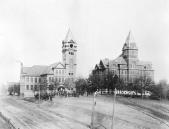In 1934, the Board of Regents of the University System of Georgia (USG) was exploring ways to boost the struggling state economy by maximizing its education infrastructure. The nation was still in the grip of the Great Depression.
W. Harry Vaughan, associate professor of ceramics at the Georgia Institute of Technology (Georgia Tech), pointed out to the Regents that in 1919, the General Assembly had authorized — but not funded — the establishment of an engineering experiment station. And it just so happened that Vaughan and two colleagues had prepared an operational blueprint for such a station in 1929.
The Regents voted to allocate $5,000 of USG funds toward establishing an engineering experiment station, effective July 1, 1934. Research at Georgia Tech through the State Engineering Experiment Station (EES) — now known as the Georgia Tech Research Institute — was finally a reality.
As stated in the original authorization act, the EES' purpose was to conduct research applicable to "any or all branches of engineering, manufacturing and the industries and the science related thereto."
Vaughan was named director. He supervised 13 part-time faculty and a handful of graduate assistants.
Early Operations
The EES was established at Georgia Tech by the General Assembly of the State of Georgia, and Georgia Tech supplied the infrastructure, maintenance, day-to-day oversight, and personnel support. The state provided the EES with its own budget allocation, which sponsored research funds would augment as projects were signed up.
The EES was modestly housed in the basement of the Old Shop Building. The director's office was on the third floor of another building, and tools were rented from the mechanical engineering school.
Early Projects
Contracts arrived in a trickle, yet the EES accumulated impressive early achievements. It focused primarily on textile and ceramics work.
Early projects included:
- Development of cotton roving and spinning processes that were three to five times faster than what was then common in the industry.
- A complete viscose rayon facility in which the first rayon from Georgia pine pulp was developed.
- Creation of a process for weaving fabric from domestic flax and flax blends for use in suits, towels, parachute webbing, and other items.
- A Georgia Economic Survey.
- New paint primers for southern yellow pine.
- A study of the properties of abietic acid.
- High-quality fire bricks produced from Georgia kaolin.
- An x-ray study of the effects of processing on synthetic fibers.
In addition, EES' reputation as a leader in helicopter research started in the 1930s with its work on aviation's great marvel of the time, the autogyro — a stubby, winged aircraft that was pulled forward by a propeller mounted at the front.
By the end of the 1937-1938 fiscal year, the EES staff had grown considerably, as indicated in the annual report. In addition to Vaughan, individuals who performed work at the EES included a secretary-bookkeeper, two machinists, a draftsman, and two faculty research associates. Also, there were four faculty "serving without pay," three research fellows, two full-time research assistants, 10 research graduate assistants, one research scholar, three research student assistants, and seven "skilled workers from the W.P.A." — the Roosevelt administration's Works Progress Administration and funded by the U.S. government. Unfortunately, the report did not consistently distinguish between paid and unpaid, and full- and part-time personnel.


